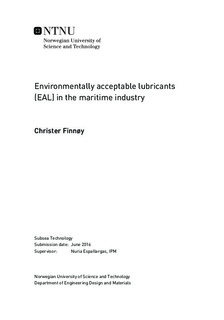Environmentally acceptable lubricants (EAL) in the maritime industry
Master thesis
Permanent lenke
http://hdl.handle.net/11250/2406352Utgivelsesdato
2016Metadata
Vis full innførselSamlinger
Sammendrag
All dynamic mechanical equipment needs lubrication to perform in a best possible way. Inthe maritime industry, e.g. ships, many of the most important dynamic mechanical systemsare located beneath the surface of the sea. Examples of equipment are thrusters, stern tubesand ship stabilizers. All these components are dependent on proper lubrication to performoptimally and secure a long service-life. In the interface between the seawater moving parts, aseal is required to separate the oil and seawater from each other. Due to new requirements,conventional mineral oil shall be exchanged with an environmentally acceptable lubricant(EAL).In this study dierent elastomers were tested against dierent steels (S355-steel and NiCrsteel)with two dierent oils (Shell Omala 68 and Kl uberbio EG 2-68). The motivationfor performing the tests was to identify the tribological properties of the elastomers in therequired EAL compared to the oil in use, and occurring mechanisms and the chemomechanicaleects of the lubricants in interaction with the seal. The testing was performed at labscale using a "Pin-on-plate" conguration in a tribomachine. To investigate the eect ofthe lubricants on the elastomers two soaking tests were performed, and soaked samples weretribologically evaluated.The result from this study showed that the conventional mineral oil give the lowest coecientof friction (COF) when comparing the two oils. When comparing the elastomers, NBRshowed a lower COF than FKM. It was concluded that all the elastomers are operating ina boundary/mixed lubrication regime. NBR exhibit higher wear compared to FKM in mostsituations, exceptions are when adding abrasive particles (Silicon Carbides) to the lubricantand the contact pressure (CP) is low. Transfer of polymer from adhesive wear towards themetal surface could be observed for all elastomers. The results from the soaking tests showedthat EAL degrade NBR more than conventional oil and that higher temperatures acceleratethe degradation. In the soaking test FKM gained mass from aging. This study gives pointersof expected behaviour in the sealing system.
